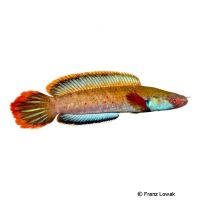Fire and Ice Snakehead (Channa sp. 'Fire and Ice')
| Fire and Ice Snakehead Channa sp. 'Fire and Ice' | |
|---|---|
| Name | Fire and Ice Snakehead |
| Name Lat. | Channa sp. 'Fire and Ice' |
| Family | Snakeheads |
| Family lat. | Channidae |
| Order | Labyrinth Fishes |
| Order lat. | Anabantiformes |
| Origin | South Asia |
| Habitat | Rivers, floodplains |
| Diet | Carnivore |
| pH | 6.0-7.5 |
| Behavior | Predatory |
| Keeping | Individual |
| Care Level | Moderate |
| Reproduction | Mouthbrooder |
| Breeding | Difficult |
| Life Span | N/A |
| Protection | No |
| Metric Units | |
| Size | 12-15 cm |
| Temperature | 22-28 °C |
| Hardness | 5-15 °dH |
| Aquarium | 100 cm / 200 l |
| US Units | |
| Size | 4.7"-5.9" |
| Temperature | 72-82 °F |
| Hardness | 89-267 ppm |
| Aquarium | 50 gal |
Distribution and habitat
The Fire and Ice snakeheads are found in the Salween River basin, in the border region of Myanmar and Thailand. They live in shallow, slow-flowing waters, swamps and floodplains with dense underwater vegetation, hidden among roots, stones and fallen leaves.
Maintenance
They need an aquarium with dense planting, with many hiding places such as stone caves (e.g. perforated rock) and roots, as well as free swimming space. A dark sand substrate covered with some foliage (e.g. sea almond tree or beech leaves) and subdued light (floating plants) is ideal.
No ammonia, ammonium and nitrite should be detectable, the nitrate value should not exceed 100 mg/l. To ensure water quality and oxygen content, a filter and heater adapted to the aquarium size is required, as well as lighting for the species-appropriate day-night rhythm of the animals.
Diet
They are voracious predators. The diet consists of insect larvae, shrimp, mysis, small crabs, crab meat, and fish, which is readily accepted even frozen, or a commercial frozen food mix supplemented with live earthworms. Dry food is occasionally accepted, but should not be the main diet.
Only feed as much as will be eaten immediately (in 10 minutes or less). Regular and varied feeding promotes health and avoids deficiency symptoms
Behaviour and compatibility
Juveniles are compatible with each other, adults are aggressive within the species. In a larger tank, structured with many hiding places, pair keeping is also possible. They can be socialized well with calm, large fish, which they do not regard as prey
In principle, only mutually compatible fish species with similar requirements to the water condition and water temperature may be socialized.
Sex dimorphism
The sexes are difficult to distinguish. Females are slightly larger and rounder, especially at spawning time.
Reproduction and breeding
There are isolated reports of successful breeding in the aquarium. They are mouth brooders in which the male takes over the brood care (paternal mouth brooders). After mating, the eggs float to the water surface and are collected by the male for mouth brooding. After about 10 days, the fry are released and swim freely. Unfertilized eggs are released by the female, which sink to the bottom and serve as food for the fry
These must be fed sufficiently several times a day with cyclops or Artemia nauplii, otherwise they will eat each other.
Important
The name "Fire and Ice" comes from the red (Fire) and blue (Ice) coloring on the head
The fish should not be offered meat from mammals (beef, pork) or poultry, because it contains certain lipids that can not be digested and therefore it can lead to fat deposits and even organ degeneration.
They have an additional respiratory organ, the so-called labyrinth (suprabranchial organ) with which they breathe atmospheric air and can suffocate if this is not possible
Since they like to jump, the aquarium must be well covered.
The well-being of the fish should be checked regularly. Temperature should be checked daily, pH, hardness and nitrate levels at least every 14 days. Regular partial water changes are recommended, even if the contaminant level has not yet reached the upper limit. Sudden changes in water quality should be avoided. Newly introduced fish must be accustomed slowly to the water in the aquarium.
Further literature can be found in your pet store.
References
Text: Werner Winter; Image: Franz Lowak
Source: BMELV (1998): Tierschutzgutachten - Haltung von Zierfischen (Süßwasser); ENGELMANN (2005): Zootierhaltung - Tiere in menschlicher Obhut: Fische, Verlag Harri Deutsch
- Gemäß § 21 Abs. 5 Tierschutzgesetz idgF
